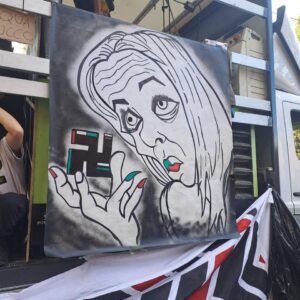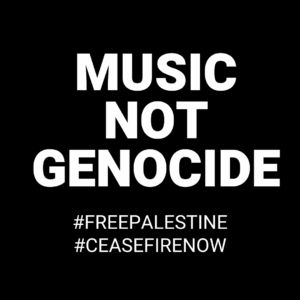
We publish below a contribution that, from his partial point of view, looks at events recently happened and wish to encorage a debate that surely cannot be exhausted in some occasional document or comparison, with the need for further verification and opening up to various suggestions, inputs and critical thinking.
(For contributions write us to smashrepression@proton.me)
As a “thunderous gasp”, the application of the anti-rave decree has awakened in the world of counter-cultures as sub-cultures (at least in South and Western Europe) a need for:
- opposition to those who enact laws, prohibitions and interdictions and those who apply them in different forms;
- to know and better act on this need and desire for opposition, to have to look around, to get out of the “bubble” (often facilitated by the hypertrophy of relationships via social media) and to understand what other forms of opposition there are in the present.
It is clear how this mixture of needs has seen a great convergence of biographies and identities in the Italian ground, to the point of juxtaposing the “closed” dispute (rejection-abolition of the decree then law) with a whole series of claims linked to it (prevailing repression of the usability of counter-cultural spaces, of social instances, of the very possibility of assembly – as underlined in a rather bland way in public opinion when its unconstitutionality was dismissed). [1]


We have found ourselves intimately bound by the yearning for freedom, both for those who are an integral part of the free-underground-tekno world, and for those who see in the safeguarding of diversity and possible forms of expression and the avoidance of homologation a key element of resistance. Certainly, the widening (or re-widening) of the value horizon and the desired ones for which we have found each other, in short, in the same magma, has given rise to a latency dictated by the same stratification and sectarianism of languages and knowledge that characterizes the fragmentation of society. As often happens, the materialization of the repressive machine has highlighted the unavailability of bodies and minds to submit to its yoke on the one hand, and the need to be able to connect in order to oppose to forms of structural oppression on the other.
It was understood how the anti-rave “device”, in a growing context of militarization of physical spaces as well as consciences, first of all in the “Fortress Europe” [2], on the one hand responded to satisfy the forklift appetite in search of the “slackers, misfits, maintainers” and whoever else, on the other it preluded the implementation of the control and security devices that we see today with the red zones and the Italian Security Bill, in the way of approuval into June. [3]
In evidence, the compression of the spaces of sociality, debate and critical expression tell us about the exponential militarization of this present, linked to the desire for the suppression and subjugation of “minorities” who are deserters and less inclined to domestication. The prohibitionist rhetoric inherent in the new Highway Code (formally unconstitutional) is in part also a form of this propaganda that strongly drives to the homologation of individual-collective thought and time.
It was also clear how, in the overflow of energy and desires that has occurred since the beginning of the broad and molecular mobilization against the anti-rave law, seemingly distant and irreconcilable lifestyles and languages were encountered: this was to explain to many “new” people in the environment the oppression that those who organized parties in Italy had already suffered for years, and to find a way to tell it clearly to those who did not live it directly. Or go and make it clear immediately, the need – for example – for self-protection and self-determination in the face of the structural forms of sexist violence that cross every area of society, and also the “bubble” of short/temporary/zones.
Related to the fanaticism of meeting to counter the governor moves, many questions have accumulated concerning an entire world in turmoil worthy of further study and synchronization.

From the emotional debate, sometimes frontal, that has occurred in many parts of Italy and beyond, it has emerged that for some the “free”-party is understood as an “escape from reality”, in the sense of fleeing from the disgust given by daily social injustices, avoiding, abstaining, dissociating, (form defined by many as “a-politics”, for others more “pre-politics” and, in any case, the willingness not to be represented in any form), while others understand it as a moment of construction of a being together allusive of new possible worlds and horizons (“political” form). A form of leisure and a form of recreation. This encounter between perceptions cannot be seen as divisive: both suppose a marked tendency to defect from “current normality” and warmongering, starting from different forms of rejection and creation of expressive modes linked to it.
In this rebound between the need to express oneself there have been often misunderstandings, setbacks between generations that communicate their technical and empirical knowledge related to the reproduction of the expression of the idiophonic content or between those who felt the need to highlight the importance of equality and gender issues in the festive contexts they lived, as a constitutive expression of “alternativity” in self-managed moments, beyond their aesthetic reproducibility.
Now… we know that in the urgency of the mobilizations there is an even overrated radicalization of concepts and of the ego – to assert one’s voice in a vortex of demands; this does not mean in reality that there are no comrades in the crews who do not practice anti-fascism and anti-sexism everywhere (far from it, and almost always far from radical-chic as much as from a spokesperson for some instance), despite having expressive codes perhaps very different from “classic” militants of a young collective that is now fighting on the street, as well as there are companions who decide among other to be sound engineers, cabling and travelling for passion and lifestyle without renouncing the anti-patriarchal practice as a form of existence and resistance e and daily liberation. Trans-feminist assertion of care of relationships and care of the events: mix of the hype in being at the party.
Anyway, we would wonder how it is that these needs for interaction and comparison have not emerged before the repressive imposition evident by law… that is, a counter-culture like that of the rave (not only free-tekno genre), decades old, in its up and down, often (fortunately!) not measurable by the number of participants in events, oscillates between the possibility of being absorbed by the communication and commodification systems and the hostility open to them… Can it somehow be updated in its forms, hybridized with other experiences, become the vector of the “old” and “new” impulses that agitate it? It can only be the result of a primordial response to the attempt to demonize – penalize – mystify the rave, as happened once again in its history, in this case in Italy at the hands of the Meloni – Salvini – Piantedosi Government. We have to spread what’s going on in the country to prevent further repression in other states as well.

Was it a good thing to respond to the sneaky “we take you out of the sheds (and maybe regularize)” with “we invade the streets of your showcase and smart cities”? We say “Yes”, and it created interactions and contamination of styles and genres such as had not been seen for a long time in many locations, and activated energies in contexts where they had hardly occurred before in certain ways. [4]
Now, when new crews and youths begin to experiment with different practices of self-management beyond the street parades, the need for the circulation of confrontation and debate not subside must not and cannot decay, on the contrary it should make use of greater proactivity among those who have accumulated experiences of even decades as by those who live them now; this is because (as various cycles of anti-repression struggle in France can show) it is not with the end of the repressive “bogeyman” that then the forms of aggregation become in themselves stronger and more conscious in self-management than the previous ones, if then the “new” does not recognize and listen; on the contrary, it is precisely in the closure of possibilities of intercommunication that a movement of bodies, relationships and knowledge becomes more attackable, except when physically, pecuniarily or administratively, it tends to ghettoize or be commodified (in the double and subtle blackmail: either hetero-normalized festival or confine).
The initial intuition of the contamination between anti-repressive issues, of comparison and recognition between “minorities”, is a trend that should not be put in the background with respect to the reproducibility of events: it endows counter-cultures with new antibodies to the commodification and absorption of them, and regenerates with the creation of a mosaic of resistance to some forms of control and homologation, starting from the conception of what is defined and perceived as freedom and what is not.

De facto, alternative expressive creation needs to experiment between styles and genres in addition to frontal “opposition” to state enemies, and to refine mechanisms of self-defense and forms of re-appropriation of space and time (of which the mode of celebration can be considered among the sublime ones). Not stopping to look around, even in seemingly difficult and narrow moments, such as those of contentment, is an anti-repressive and libertarian antidote. Whether it is through solidarity campaigns, the dissemination of anti-racist content and practices, care and collective self-protection, or defending sound in a situation where there is little few.
In these times it is very easy to satisfy the desire of meeting and partying perhaps thousands and thousands of kilometers away but at the same time not being able to see or know who tries to practice it a stone’s throw from our daily lives: this is also a limitation of the possibilities of choosing where to go and relate to each other. Today, more than in the past, seeking and making liaisons* is an indispensable dimension of reciprocity, belonging and counter-cultural experimentation.
*liaisons, in place of “nets” or “networks”: to underline the basic importance of verbal/physical interactions rather the virtual one’s embedded. Nonetheless, taking care of those people who cannot stay in situation to communicate with them using other tools than the direct speech, and acting to strengthen co-participation more and more…
[1] https://www.vice.com/en/article/italy-decreto-anti-rave-protest/
[4] https://mixmag.net/feature/defiant-photos-bologna-smash-repression-pro-rave-protest-meloni
https://smashrepression.noblogs.org/ https://linktr.ee/musicresistance_smash


